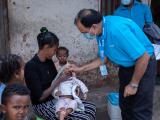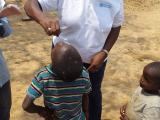A World Health Organization (WHO) emergency committee that has been meeting regularly to review polio developments after a public health emergency was declared 4 years ago raised deep concerns today about an increase in wild poliovirus type 1 (WPV1) cases in Afghanistan and the spread of vaccine-derived strains elsewhere in the world.
The committee met in Geneva on Nov 27 for the 19th time since 2014, and after reviewing the latest global polio developments unanimously agreed that the risk of international spread still constitutes a public health emergency of international concern (PHEIC).
At a media telebriefing today, Helen Rees, MBBS, who chairs the committee and is a professor at the University of the Witwatersrand in Johannesburg, South Africa, said the world is "a whisker away from eradication," but progress is fragile. She added that health officials fear a resurgence of the disease that could reverse all of the hard work accomplished by countries and health partners. "We certainly cannot allow that to happen."
She said if wild poliovirus cases continue year after year, eradication will never be accomplished, and the tables will tilt in the direction of the poliovirus winning, Rees said, adding, "We have to finish this job."
One PHEIC, but a dual emergency
Michel Zaffran, MEng, director of the WHO's polio eradication program, said the ongoing PHEIC reflects a dual emergency, both of which pose a threat to other countries: the continued spread of WPV1 in Afghanistan and Pakistan and spread of circulating vaccine-derived poliovirus (cVDPV) in countries that have poor or weak routine immunization programs, such as in Africa and in Papua New Guinea.
He said eradicating circulating vaccine-derived poliovirus hinges on phasing out remaining oral poliovirus vaccine, which can't be accomplished until WPV1 is eradicated.
As if to underscore the concerns, Afghanistan this week reported its 20th WPV1 case for the year, twice as many as this time last year, while Pakistan has reported eight WPV1 cases. Safran said several locations in both countries this year have reported positive findings for WPV in sewage sample testing.
Rees said another concern is that, because of security problems in parts of Afghanistan, polio vaccinators haven't been able to reach as many as 1 million children targeted in the campaigns.
Also five countries—the Democratic Republic of Congo, Niger, Nigeria, Papua New Guinea, and Somalia— have reported multiple cVDPV cases this year. A worrisome development in 2017 was the spread of vaccine-derived polio from Somalia to Kenya and from Nigeria to Niger.
PHEIC as a tool for eradication push
Rees said the PHEIC declaration, and the temporary response steps recommended by the emergency committee, have had an impact on the battle against polio, but she worries about complacency and donor fatigue.
She said getting into inaccessible areas to vaccinate children is crucial, so that the virus has nowhere to hide and will simply disappear globally.
Rees said the world has the tools, vaccines, policies, programs, surveillance, and commitment. "We now need to make sure we push all of that to achieve the end game."
Officials said today that bright spots include no WPV cases reported in Nigeria since 2016 and no WPV3 cases having been reported for 6 years.
ees said she worries, however, about the world losing ground against polio, similar to what's happening with measles. For both diseases, the poorest populations will feel the biggest impact if illness levels continue to rise.
Latest cases in Afghanistan, Niger
The latest WPV1 case in Afghanistan involves a 3-year-old boy from Shaheed-e-Hassas district in Urozgan province, the second from that district this year, the WHO's Eastern Mediterranean Regional Office (EMRO) said in a Nov 28 statement. It noted that the boy is now permanently paralyzed.
Of this year's 20 cases, 14 were in the south, including 9 in Kandahar and 3 in Helmand. Six cases were in the east: 3 in Kunar, 2 in Nangarhar, and 1 in Nuristan.
Ferozuddin Feroz, MD, Afghanistan's health minister, said in the statement that the country now has more polio cases than it's had in the last 2 years.
"This is serious, and we as parents, community members, and a nation have an obligation to protect our children," he said. "This young boy has been needlessly paralyzed and his life forever changed before it has even started. We must do better to protect our children."
Meanwhile, the Global Polio Eradication Initiative (GPEI) in an update today included an advance notification of the new Afghani case in its weekly update and said the boy had an Oct 9 paralysis onset. It also said there were six more positive WPV1 environmental samples from Afghanistan and two more environmental sampling positives from Pakistan.
In addition, Niger reported a cVDPV2 case, affecting a patient from Magaria district in Zinder region. The country now has eight cVDPV2 cases, with the virus genetically linked to an outbreak in Nigeria.
See also:
Nov 30 WHO statement
Nov 28 WHO EMRO statement
Nov 30 GPEI report





















